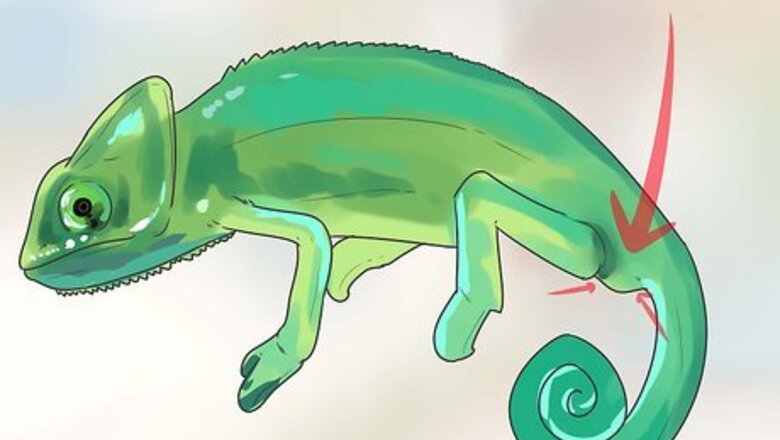
views
X
Research source
It is not always possible to sex a baby chameleon, as they do not usually develop their coloration or other sex characteristics until they are several months old.
Sexing a Chameleon of Any Species

Check for the hemi-penal bulge. Many species of chameleon exhibit some slight indication of genitalia. This is a small bulge on the underside of the male chameleon, right at the base of the tail. It may not develop until the male chameleon is several months old. Female chameleons will be smooth at the base of the tail.

Observe the color. Chameleon coloration varies widely by species, but it is not unusual for male chameleons to be more brightly colored. In many common species, it is only the male who develops striking coloration. If you buy a baby chameleon, its colors may not have developed. Depending on the species, it may be several months before your chameleon's color comes in. Female chameleons may exhibit fascinating colors when in heat, and startling patterns when gravid, carrying eggs.

Check size. In most species of chameleon, males tend to be larger. This difference can be inconspicuous or striking, with the male growing to twice the size of the female. Size, however, varies hugely depending on species and care. Some species do have larger females, and others have no size difference at all.

Learn your chameleon's species. If you know the species, look up the sex characteristics and determine whether yours is male or female. If you do not yet know the species of chameleon, visit a library or go online and read about the different species. Do an image search and see what species look similar to your chameleon. There are more than 180 types of chameleon classified in the world, but only a few that are common household pets. Ask the dealer. If you didn't learn the sex or species of your chameleon when you bought it, contact the person you bought it from. This is information relevant to your chameleon's care, and they should provide you with it. If you caught your chameleon in the wild, research the kind of chameleons local to your area. However, know that capturing wild chameleons is ill-advised and may be illegal.
Sexing Common Pet Chameleon Species
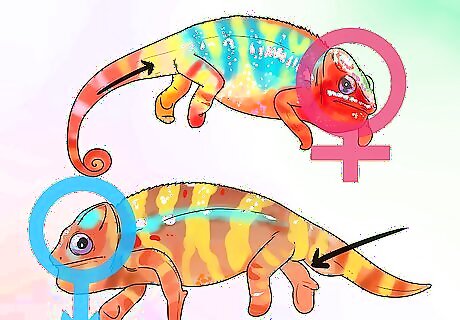
Identify the sex of a Panther chameleon. Check for a hemi-penal bulge. Male panther chameleons have a small lump at the base of the tail, while females do not. Males tend to be larger, and may grow up to 20 inches long. Panther chameleons all exhibit bright and varied coloration, but male panthers may be lovelier.

Identify the sex of a veiled chameleon. Check for tarsal spurs. The males of this species are born with small bumps on the backs of their hind legs. If your veiled chameleon has no tarsal spur, she is female. Males also begin to exhibit a hemi-penal bulge, or small lump at the base of the tail, when they are several months old. If you have several veiled chameleons, you may notice a contrast in the sizes and coloration of different sexes. Male chameleons have a bigger casque, are larger, and are more brightly colored than females. The "casque," or spur on the head, can grow to an excess of 3 inches in male chameleons.
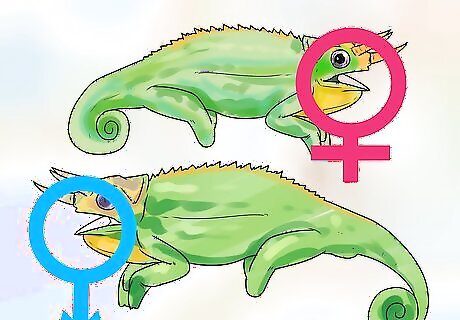
Identify the sex of a Jackson's chameleon. Check for a hemi-penal bulge, or small lump at the base of your chameleon's tail. Males will have a bump, while the underside of a female's tail base should be smooth. While both male and females of this species may bear horns above the eyes and mouth, this is more common among males.

Identify the sex of a Carpet chameleon. Check for a hemi-penal bulge. Male Carpet chameleons have a bulge at the base of their tail, and tend to be larger than females. Females will not grow to eight inches and will be smooth at the base of the tail.
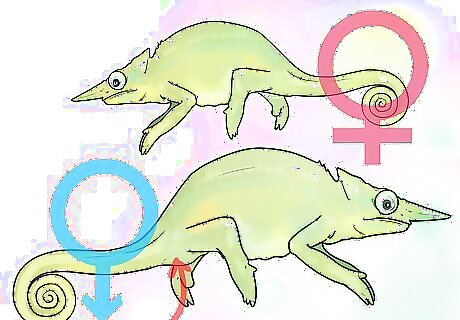
Identify the sex of a Fischer's chameleon. Check Fischer's chameleons for a hemi-penal bulge, present on males. Both males and females may have a "double rostral process," a long bumpy double face prong. These are more pronounced in males, and occasionally absent in females.

Identify the sex of a Flapneck chameleon. Measure your Flapneck chameleon. Female flapneck chameleons are larger than males, and may grow to be up to 16 inches long. Male flapneck chameleons are smaller. Check smaller chameleons for a hemi-penal bulge.

Identify the sex of a Four-horned chameleon. Check for horns. Males of this species have 2-6 horns on their faces. They also have a large crest on their back, and a casque, or head-bump. Males have a hemi-penal bulge. Females are altogether smoother, possessing neither bulge, horns, crest, or casque.

Identify the sex of a Meller's chameleon. Check for eggs. It is extremely difficult to sex Meller's chameleons, as they are virtually identical in appearance. If you have multiple Meller's chameleons, try to catch them mating. A female may lay eggs. Outside of this, an x-ray may be the only way to determine the sex of your chameleon
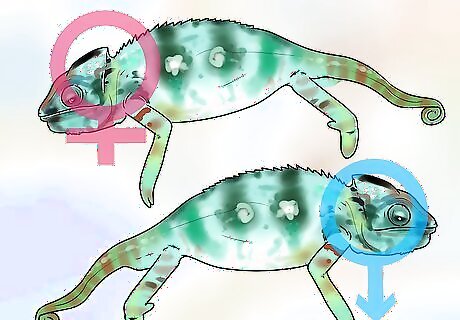
Identify the sex of an Oustalet's chameleon. Check for green color. Only female Oustalet chameleon's may be green. Both males and females may be grey, brown, black, or white. Check as well for a hemi-penal bulge, indicative of a male. Females are smaller, while males may grow to be as long as 30 inches.



















Comments
0 comment